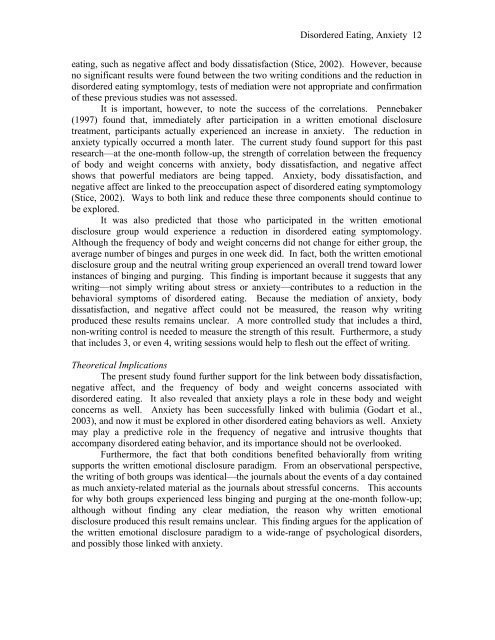The Secret Society: Descendants of Crypto-Jews in the San Antonio ...
The Secret Society: Descendants of Crypto-Jews in the San Antonio ...
The Secret Society: Descendants of Crypto-Jews in the San Antonio ...
You also want an ePaper? Increase the reach of your titles
YUMPU automatically turns print PDFs into web optimized ePapers that Google loves.
Disordered Eat<strong>in</strong>g, Anxiety 12<br />
eat<strong>in</strong>g, such as negative affect and body dissatisfaction (Stice, 2002). However, because<br />
no significant results were found between <strong>the</strong> two writ<strong>in</strong>g conditions and <strong>the</strong> reduction <strong>in</strong><br />
disordered eat<strong>in</strong>g symptomlogy, tests <strong>of</strong> mediation were not appropriate and confirmation<br />
<strong>of</strong> <strong>the</strong>se previous studies was not assessed.<br />
It is important, however, to note <strong>the</strong> success <strong>of</strong> <strong>the</strong> correlations. Pennebaker<br />
(1997) found that, immediately after participation <strong>in</strong> a written emotional disclosure<br />
treatment, participants actually experienced an <strong>in</strong>crease <strong>in</strong> anxiety. <strong>The</strong> reduction <strong>in</strong><br />
anxiety typically occurred a month later. <strong>The</strong> current study found support for this past<br />
research—at <strong>the</strong> one-month follow-up, <strong>the</strong> strength <strong>of</strong> correlation between <strong>the</strong> frequency<br />
<strong>of</strong> body and weight concerns with anxiety, body dissatisfaction, and negative affect<br />
shows that powerful mediators are be<strong>in</strong>g tapped. Anxiety, body dissatisfaction, and<br />
negative affect are l<strong>in</strong>ked to <strong>the</strong> preoccupation aspect <strong>of</strong> disordered eat<strong>in</strong>g symptomology<br />
(Stice, 2002). Ways to both l<strong>in</strong>k and reduce <strong>the</strong>se three components should cont<strong>in</strong>ue to<br />
be explored.<br />
It was also predicted that those who participated <strong>in</strong> <strong>the</strong> written emotional<br />
disclosure group would experience a reduction <strong>in</strong> disordered eat<strong>in</strong>g symptomology.<br />
Although <strong>the</strong> frequency <strong>of</strong> body and weight concerns did not change for ei<strong>the</strong>r group, <strong>the</strong><br />
average number <strong>of</strong> b<strong>in</strong>ges and purges <strong>in</strong> one week did. In fact, both <strong>the</strong> written emotional<br />
disclosure group and <strong>the</strong> neutral writ<strong>in</strong>g group experienced an overall trend toward lower<br />
<strong>in</strong>stances <strong>of</strong> b<strong>in</strong>g<strong>in</strong>g and purg<strong>in</strong>g. This f<strong>in</strong>d<strong>in</strong>g is important because it suggests that any<br />
writ<strong>in</strong>g—not simply writ<strong>in</strong>g about stress or anxiety—contributes to a reduction <strong>in</strong> <strong>the</strong><br />
behavioral symptoms <strong>of</strong> disordered eat<strong>in</strong>g. Because <strong>the</strong> mediation <strong>of</strong> anxiety, body<br />
dissatisfaction, and negative affect could not be measured, <strong>the</strong> reason why writ<strong>in</strong>g<br />
produced <strong>the</strong>se results rema<strong>in</strong>s unclear. A more controlled study that <strong>in</strong>cludes a third,<br />
non-writ<strong>in</strong>g control is needed to measure <strong>the</strong> strength <strong>of</strong> this result. Fur<strong>the</strong>rmore, a study<br />
that <strong>in</strong>cludes 3, or even 4, writ<strong>in</strong>g sessions would help to flesh out <strong>the</strong> effect <strong>of</strong> writ<strong>in</strong>g.<br />
<strong>The</strong>oretical Implications<br />
<strong>The</strong> present study found fur<strong>the</strong>r support for <strong>the</strong> l<strong>in</strong>k between body dissatisfaction,<br />
negative affect, and <strong>the</strong> frequency <strong>of</strong> body and weight concerns associated with<br />
disordered eat<strong>in</strong>g. It also revealed that anxiety plays a role <strong>in</strong> <strong>the</strong>se body and weight<br />
concerns as well. Anxiety has been successfully l<strong>in</strong>ked with bulimia (Godart et al.,<br />
2003), and now it must be explored <strong>in</strong> o<strong>the</strong>r disordered eat<strong>in</strong>g behaviors as well. Anxiety<br />
may play a predictive role <strong>in</strong> <strong>the</strong> frequency <strong>of</strong> negative and <strong>in</strong>trusive thoughts that<br />
accompany disordered eat<strong>in</strong>g behavior, and its importance should not be overlooked.<br />
Fur<strong>the</strong>rmore, <strong>the</strong> fact that both conditions benefited behaviorally from writ<strong>in</strong>g<br />
supports <strong>the</strong> written emotional disclosure paradigm. From an observational perspective,<br />
<strong>the</strong> writ<strong>in</strong>g <strong>of</strong> both groups was identical—<strong>the</strong> journals about <strong>the</strong> events <strong>of</strong> a day conta<strong>in</strong>ed<br />
as much anxiety-related material as <strong>the</strong> journals about stressful concerns. This accounts<br />
for why both groups experienced less b<strong>in</strong>g<strong>in</strong>g and purg<strong>in</strong>g at <strong>the</strong> one-month follow-up;<br />
although without f<strong>in</strong>d<strong>in</strong>g any clear mediation, <strong>the</strong> reason why written emotional<br />
disclosure produced this result rema<strong>in</strong>s unclear. This f<strong>in</strong>d<strong>in</strong>g argues for <strong>the</strong> application <strong>of</strong><br />
<strong>the</strong> written emotional disclosure paradigm to a wide-range <strong>of</strong> psychological disorders,<br />
and possibly those l<strong>in</strong>ked with anxiety.
















